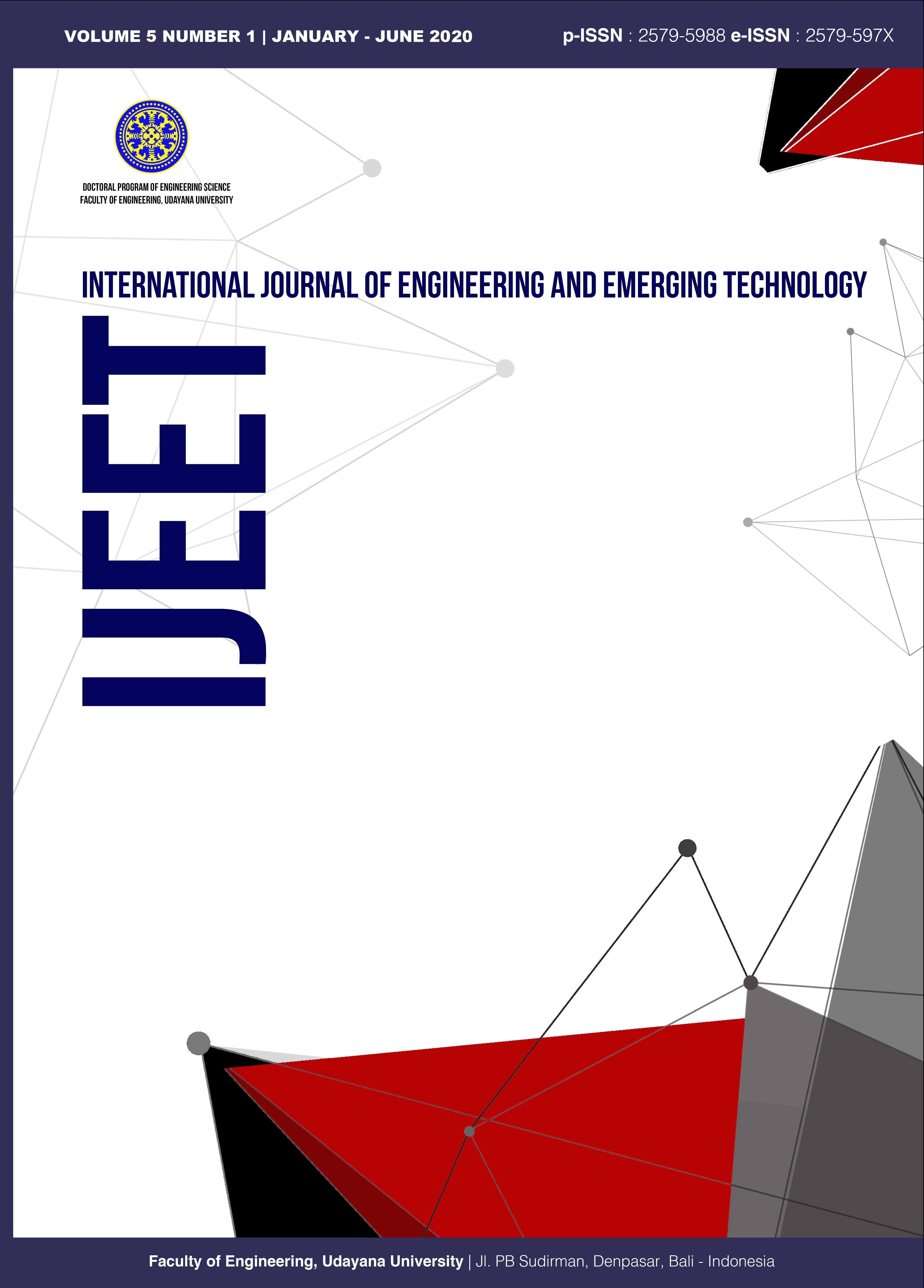Ornamental Variety of Garuda and Wilmana on Padmasana Architecture at Kahyangan Jagat Temple in Bali, Indonesia
Abstract
Garuda was known in prehistoric India, where his paintings were found in the Harappa (Sindhu River valley), then spread to all corners of the world affected by Indian civilization. Its head, beak and claws are eagles, the light of the gods shining from its body. While Wilmana as a picture of a space vehicle that moves beyond the speed of thought. Wilmana is also a worldwide character, presented in the world of the internet, film and games. Padmasana architecture is a sacred building as a place/position of God, on the back is often carved by the two kinds of decoration. This research about ornamental variety is research in the context of traditional architecture, as an exploration of building concepts that have been developed in the past and are useful to apply to contemporary architecture. This study aims to re-express the meaning of Garuda and Wilmana and how they are placed on Padmasana architecture. The steps taken are to record the Padmasana in the Kahyangan Jagat Temple in Bali, followed by comparing the use of these two types of decoration on each Padmasana. The next step is to interpret the meaning by connecting the object with its past (expanding the horizon of the researcher). The results of the study show that the use of Garuda and Wilmana decoration in the Padmasana architecture is not a necessity. The use of Garuda points to the message that humans must try to free themselves from the bondage of worldly passions. While the use of Wilmana refers to the sky vehicle that carries passengers, both Giant and Dewata to the place they want. Both are symbolic decoration types, have the same position, placed on the body behind the padmasana. The position of the two becomes different if applied together, Garuda is placed in a position above Wilmana, because only a soul that has been freed from worldly slavery can ride Garuda.
Downloads
References
[2] Adhika, I Made and Dwijendra, Ngakan Ketut Acwin. (2020). Selfie Photos Area and Its Implication to Water Availability and Social Culture in Wanagiri Village, Bali Indonesia. In: International Journal of Psychosocial Rehabilitation, Vol. 24, No. 4, DOI: 10.37200/IJPR/V24I4/PR201652.
[3] Anonymous. 1896. The Hymns of the Rigveda. Translated by Ralph T. H. Griffith. New Delhi : Munshiram Manoharlal. p. 27, p. 90.
[4] Anonymous. 1990. Bomantaka. Translated by I.W. Warna, Sura. I.G., Sujana, I.N., Japa, I.W., Medera, I.N., dan Alit. I.K. Denpasar: Dinas P&K Bali. p. 19.
[5] Anonymous. 2000. Himpunan Keputusan Seminar Kesatuan Tafsir Terhadap Aspek-Aspek Agama Hindu I-XV. Denpasar: Pemerintah Propinsi Bali. p. 12, p. 87.
[6] Bharadwaaja, M. 1973. The Vimanika Shastra. Translated by G.R. Josyer. Mysore-4, India: Coronation Press. pp. 1-7.
[7] Choudhury, P. 2005. The Concepts Of Purusa, Prakrti And O La In Sankaradeva’s Philosophy. Vol. Doctor, Department of Philosophy. Guwahati: University of Gauhati. p.171, 350-356.
[8] Debroy, B., dan Debroy, D. 2001. Garuda Purana. Surabaya: Paramita. pp. 8-9.
[9] Dharmayanty, Ni Luh Putu Dessy, Paturusi, Syamsul Alam, Dwijendra, Ngakan Ketut Acwin, and Dewi, Ni Ketut Agusinta. (2019), Development and Behaviour Response of the Balinese Inhabitting in Denpasar City and Badung Regency, Bali-Indonesia. In: Journal of Social and Political Sciences, Vol.2, No.2, 455-467.
[10] Dwijendra, NKA (2003). Bali Traditional Housing and Settlements. Journal of Settlement Natah, Vol. 1 No. February 1, 2003: 8 - 24.
[11] Dwijendra, NKA (2008) Arsitektur Rumah Tradisional Bali, Berdasarkan Asta Kosal Kosali, Denpasar: Udayana University Press.
[12] Dwijendra, NKA (2009) Arsitektur Kebudayaan Bali Kuno, Denpasar: Udayana University Press.
[13] Dwijendra, Ngakan Ketut Acwin (2019) 'Transformation of Traditional Housing in Bungaya Village,Karangasem Bali, Indonesia', International Journal of Current Advanced Research, 08(01),pp.16793-16798. DOI: http://dx.doi.org/10.24327/ijcar.2019.16798.3118
[14] Dwijendra, Ngakan Ketut Acwin and Sueca, Ngakan Putu. (2019). The Determinant Factor of Home Transformation in Bali, Indonesia, In: The Journal of Social Sciences Research, Vol. 5, No. 12, pp 1855-1860.
[15] Dwijendra, Ngakan Ketut Acwin. (2019), Morphology of House Pattern in Tenganan Dauh Tukad Village, Karangasem Bali, Indonesia. In: Journal of Social and Political Sciences, Vol.2, No.1, 173-181.
[16] Dwijendra, Ngakan Ketut Acwin. (2020). Identity Struggle Perspective in Car-Shaped Shrine in Paluang Temple, Nusa Penida Bali, Indonesia, In: International Journal of Psychosocial Rehabilitation, Vol. 24, No. 4, DOI: 10.37200/IJPR/V24I4/PR201653.
[17] Gustami, S. 2008. Nukilan seni ornamen Indonesia. Yogyakarta: Arindo Nusa Media
[18] Kanjilal, D.K. 1985. Vimana In Ancient India (Aeroplanes Or Flying Machines In Ancient India). Bidhan Sarani, Calcutta: Sanskrit Pustak Bhandar. p. 57.
[19] Liebert, G. 1976. lconographic Dictionary of The Indian Religion: Hinduism-Buddhism-Jainism. Leiden: E.J. Brill.
[20] Macdonell, A.A. 1897. Vedic Mythology. Strassburg: Verlag Von Karl J. Trubner. p. 39, P. 41.
[21] Mardiwarsito, L. 1990. Kamus Jawa Kuno Indonesia. IV ed. Flores-NTT: Nusa Indah. p. 451.
[22] Margaret, dan Stutley, J. 1977. A Dictionary of Hinduism. London WC1E 7DD and Broadway House: Routledge & Kegan Paul Ltd. pp. 397-398, pp. 256-258.
[23] Monier-Williams. 1899. Sanskrit-English Dictionary. Amen House, London E.C-4: Oxford University Press. p. 640, p. 980.
[24] Nurjani, Ni Putu Suda, Paturusi, Syamsul Alam, Dwijendra, Ngakan Ketut Acwin, and Putra, I Dewa Gede Agung Diasana. (2019), Morphology of Backpacker Dormitory Inside Traditional Balinese House, Canggu Village, Bali, Indonesia. In: Journal of Social and Political Sciences, Vol.2, No.3, 514-521.
[25] Sunaryo, A. 2009. Ornamen Nusantara. Semarang: Dahara Prize. pp. 3-17.
[26] Wilkins, W.J. 1923. Hindu Mythology, Vedic and Puranic. Calcutta: Thacker, Spink & Co. pp. 168-169.
[27] Williams, G.M. 2003. Handbook of Hindu Mythology. Santa Barbara, California: ABC-CLIO, Inc. pp. 138-139.
[28] Zimmer, H. 1946. Myths And Symbols In Indian Art And Civilization. Washington, D. C: Bollingen Foundation. p. 76.
[29] Zoetmulder, P.J. 2005. Adiparwa. Surabaya: Paramita. pp.53-76.

 Indexed By
Indexed By







